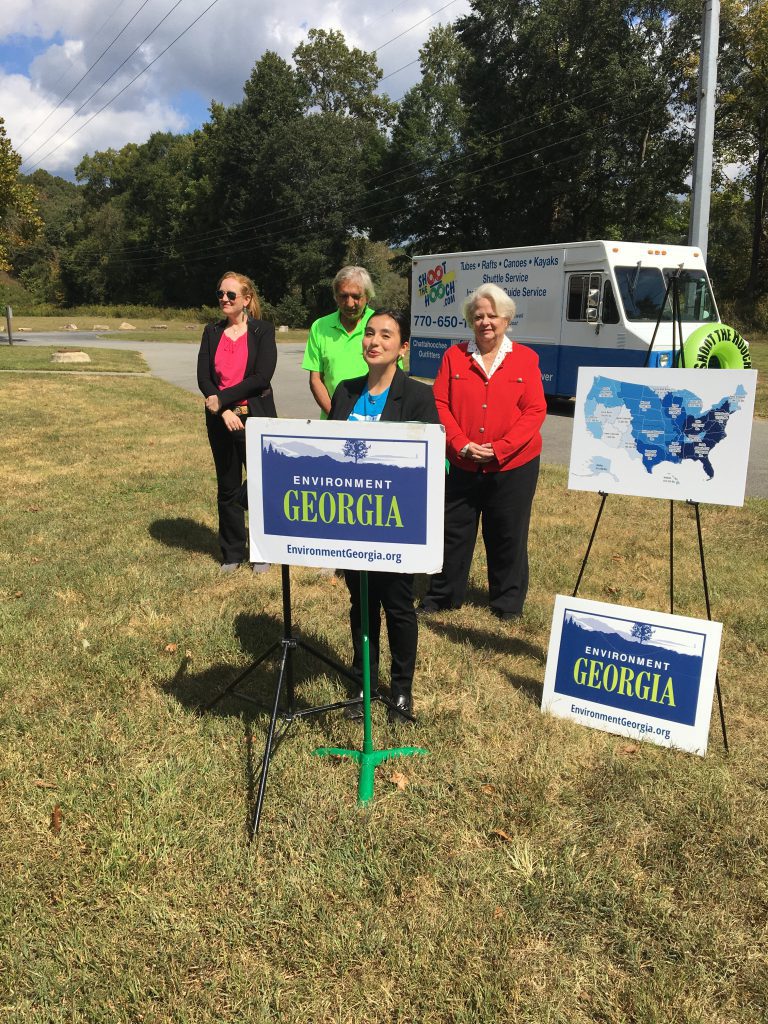Everything we put into the environment eventually washes into our waterways. Fifty years ago the Clean Water Act was a bold step forward in cleaning up our water. In the past 50 years the US has made great strides in removing water-borne diseases and making sure rivers don’t catch on fire.
But we can’t stop here –
Environment America recently released a Wasting Our Waterways report that demonstrates the continued need for the Clean Water Act and a strengthening of its protections. Approximately half our lakes and rivers are still too polluted to allow safe swimming and fishing. Too much waste still ends up in our waterways. Especially in historically marginalized areas. Industrial facilities have recently dumped a high volume of toxic chemicals into Georgia’s rivers, placing Georgia on the top 10 list of most cancer-causing and developmental toxic chemical releases.

On Oct 4, 2022, Amy Sharma, Executive Director of Science for Georgia, joined Jennifer Duenas, Public Health Advocate with Environment Georgia, Georgia State Representative Mary Margaret Oliver, and Bill Odrey, Shoot the Hooch, Atlanta Tube, Raft and Kayak Rental Business for a press conference on the banks of the Chattahoochee River.
Watch the FB Live of the Conference Here.
Over the past 50 years we have learned about new toxins and relooked at the severity of known toxins. The coverage of the Clean Water Act needs to be updated to reflect this new knowledge to reduce the amount of toxins that are produced and ultimately enter our waterways
Actions for the Next 50 Years
The low hanging fruit is to clean up existing trash, upgrade our infrastructure, and hold point source polluters accountable.
But, the research points to a bigger problem of non-point source pollution. This is harder to regulate as every single one of us contributes to it. From the plastics in our water bottles and clothes, to fertilizer for our lawns and crops, to the roads we drive on, to construction, to concentrated animal feeding operations. The price of progress are pollutants we had not paid much attention to 50 years ago – namely microplastics, PFAS, and sometimes just an overabundance of nutrients.
These further throw ecosystems out of balance, harm fisheries, and end up in the water we drink and the food we eat.
So what do we do about this? We reduce and we remediate.
Reduce
One. Hold polluters accountable based on current laws. Upgrade our definitions and legal limits. Contaminant limitations should reflect current knowledge, not 1970s science.
This only goes as far as the Government’s ability to hold polluters accountable. We must preserve the Clean Water Act, upgrade it to reflect new realities, and make sure the EPA has the money needed to operate.
Two. Stop putting so many contaminates in the waterways in the first place. We can all help by reducing our own plastic consumption and supporting policies that improve regulations to reflect the true health and environmental impact.
Remediate
One. Remediate waste by not ignoring or abusing nature’s water filters namely wetlands and grasslands. These ecosystems punch above their weight, sinking 30 to 50 times more carbon than forests, filtering the water, and absorbing the impact of severe storms.
Two. Support research into improved filtration and remediation.
Microplastics can pass through our current water filtration systems. Research is being conducted into finer meshes, and scientists are even exploring the use of natural coagulating agents, such as the goo from okra that makes our gumbo so thick, to catch suspended microparticles.
As for PFAS – the reason they were useful is also the reason they are everywhere and impervious to traditional water treatment techniques. Research is being conducted into activated carbon adsorption, ion exchange resins, and high-pressure membranes.
Further Reading
https://www.epa.gov/report-environment/drinking-water
https://www.nrdc.org/stories/water-pollution-everything-you-need-know
https://svalbardi.com/blogs/water/pollution-effect
https://www.niehs.nih.gov/health/topics/agents/water-poll/index.cfm
https://www.epa.gov/sciencematters/reducing-pfas-drinking-water-treatment-technologies
https://www.smithsonianmag.com/smart-news/microplastics-detected-in-human-blood-180979826/
https://www.niehs.nih.gov/health/topics/agents/water-poll/index.cfm
https://www.frontiersin.org/articles/10.3389/feart.2021.708895/
